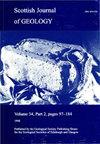苏格兰奥卡狄亚盆地中泥盆世一种新的棘棘目棘齿兽及其生物地层和生物地理意义
IF 0.5
4区 地球科学
Q4 GEOLOGY
引用次数: 8
摘要
从苏格兰北部奥卡迪亚盆地的Mey Flagstone组和Rousay Flagstone层采集了许多Cheiracantus peachi nov.sp.的部分铰接标本。这种新的、身体强壮的物种主要以放射状凹槽而不是山脊的鳞片装饰为特色。与Orcadian盆地的其他Cheiracantus物种相比,C.peachi nov.sp.的活动范围很短,是一种有用的地带化石。除了描述标本的一般形态外,我们还描述并绘制了所有元素的鳞片和组织学切片的SEM图像,从而能够识别其他分离的遗骸。生物学上特别感兴趣的是识别相对坚固的、牙齿状的鳃耙。最后,该物种也是从白俄罗斯的孤立鳞片中鉴定出来的,在那里它出现得更早,地层范围更长,这意味着该物种在东部的海洋沉积物中进化,并通过河流系统向西迁移到奥尔卡迪亚盆地。本文章由计算机程序翻译,如有差异,请以英文原文为准。
A new cheiracanthid acanthodian from the Middle Devonian (Givetian) Orcadian Basin of Scotland and its biostratigraphic and biogeographical significance
A number of partial articulated specimens of Cheiracanthus peachi nov. sp. have been collected from the Mey Flagstone Formation and Rousay Flagstone Formation within the Orcadian Basin of northern Scotland. The new, robust-bodied species is mainly distinguished by the scale ornament of radiating grooves rather than ridges. Compared to other Cheiracanthus species in the Orcadian Basin, C. peachi nov. sp. has quite a short range making it a useful zone fossil. As well as describing the general morphology of the specimens, we have also described and figured SEM images of scales and histological sections of all elements, enabling identification of other, isolated remains. Of particular biological interest is the identification of relatively robust, tooth-like gill rakers. Finally, the species has also been identified from isolated scales in Belarus, where it appears earlier and has a longer stratigraphical range, implying the species evolved in the marine deposits of the east and migrated west into the Orcadian Basin via the river systems.
求助全文
通过发布文献求助,成功后即可免费获取论文全文。
去求助
来源期刊

Scottish Journal of Geology
地学-地质学
CiteScore
1.70
自引率
0.00%
发文量
10
审稿时长
>12 weeks
期刊介绍:
Although published only since 1965, the Scottish Journal of Geology has a long pedigree. It is the joint publication of the Geological Society of Glasgow and the Edinburgh Geological Society, which prior to 1965 published separate Transactions: from 1860 in the case of Glasgow and 1863 for Edinburgh.
Traditionally, the Journal has acted as the focus for papers on all aspects of Scottish geology and its contiguous areas, including the surrounding seas. The publication policy has always been outward looking, with the Editors encouraging review papers and papers on broader aspects of the Earth sciences that cannot be discussed solely in terms of Scottish geology.
The diverse geology of Scotland continues to provide an important natural laboratory for the study of earth sciences; many seminal studies in geology have been carried out on Scottish rocks, and over the years the results of much of this work had been published in the Journal and its predecessors.
The Journal fully deserves its high reputation worldwide and intends to maintain its status in the front rank of publications in the Earth sciences.
 求助内容:
求助内容: 应助结果提醒方式:
应助结果提醒方式:


